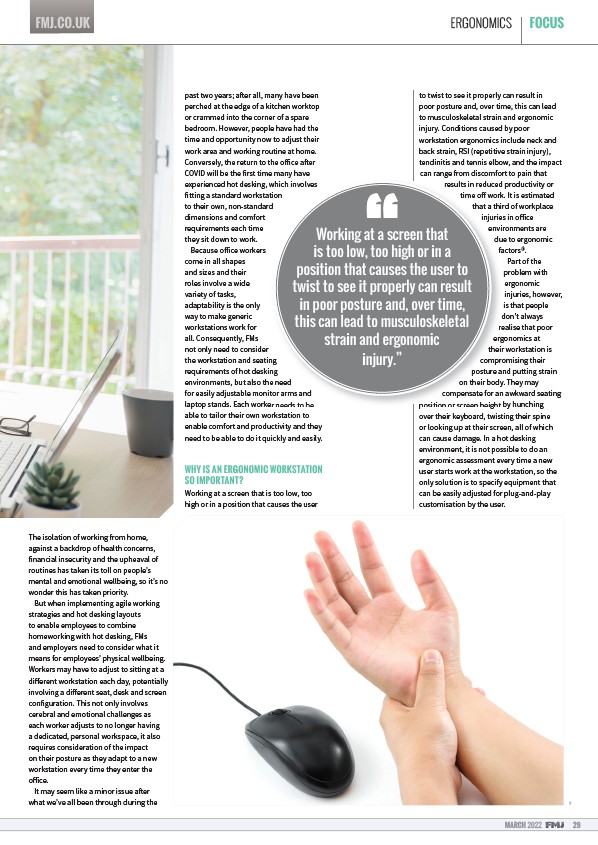
FMJ.CO.UK ERGONOMICS FOCUS
factors
MARCH 2022 29
The isolation of working from home,
against a backdrop of health concerns,
financial insecurity and the upheaval of
routines has taken its toll on people’s
mental and emotional wellbeing, so it’s no
wonder this has taken priority.
But when implementing agile working
strategies and hot desking layouts
to enable employees to combine
homeworking with hot desking, FMs
and employers need to consider what it
means for employees’ physical wellbeing.
Workers may have to adjust to sitting at a
diœ erent workstation each day, potentially
involving a diœ erent seat, desk and screen
configuration. This not only involves
cerebral and emotional challenges as
each worker adjusts to no longer having
a dedicated, personal workspace, it also
requires consideration of the impact
on their posture as they adapt to a new
workstation every time they enter the
oœ ice.
It may seem like a minor issue aª er
what we’ve all been through during the
past two years; aª er all, many have been
perched at the edge of a kitchen worktop
or crammed into the corner of a spare
bedroom. However, people have had the
time and opportunity now to adjust their
work area and working routine at home.
Conversely, the return to the oœ ice aª er
COVID will be the first time many have
experienced hot desking, which involves
fitting a standard workstation
to their own, non-standard
dimensions and comfort
requirements each time
they sit down to work.
Because oœ ice workers
come in all shapes
and sizes and their
roles involve a wide
variety of tasks,
adaptability is the only
way to make generic
workstations work for
all. Consequently, FMs
not only need to consider
the workstation and seating
requirements of hot desking
environments, but also the need
for easily adjustable monitor arms and
laptop stands. Each worker needs to be
able to tailor their own workstation to
enable comfort and productivity and they
need to be able to do it quickly and easily.
Working at a screen that
is too low, too high or in a
position that causes the user to
twist to see it properly can result
in poor posture and, over time,
this can lead to musculoskeletal
WHY IS AN ERGONOMIC WORKSTATION
SO IMPORTANT?
Working at a screen that is too low, too
high or in a position that causes the user
to twist to see it properly can result in
poor posture and, over time, this can lead
to musculoskeletal strain and ergonomic
injury. Conditions caused by poor
workstation ergonomics include neck and
back strain, RSI (repetitive strain injury),
tendinitis and tennis elbow, and the impact
can range from discomfort to pain that
results in reduced productivity or
time oœ work. It is estimated
that a third of workplace
injuries in oœ ice
environments are
due to ergonomic
factors(i).
Part of the
problem with
ergonomic
injuries, however,
is that people
don’t always
realise that poor
ergonomics at
their workstation is
compromising their
posture and putting strain
on their body. They may
strain and ergonomic
compensate for an awkward seating
position or screen height by hunching
over their keyboard, twisting their spine
or looking up at their screen, all of which
can cause damage. In a hot desking
environment, it is not possible to do an
ergonomic assessment every time a new
user starts work at the workstation, so the
only solution is to specify equipment that
can be easily adjusted for plug-and-play
customisation by the user.
injury.”